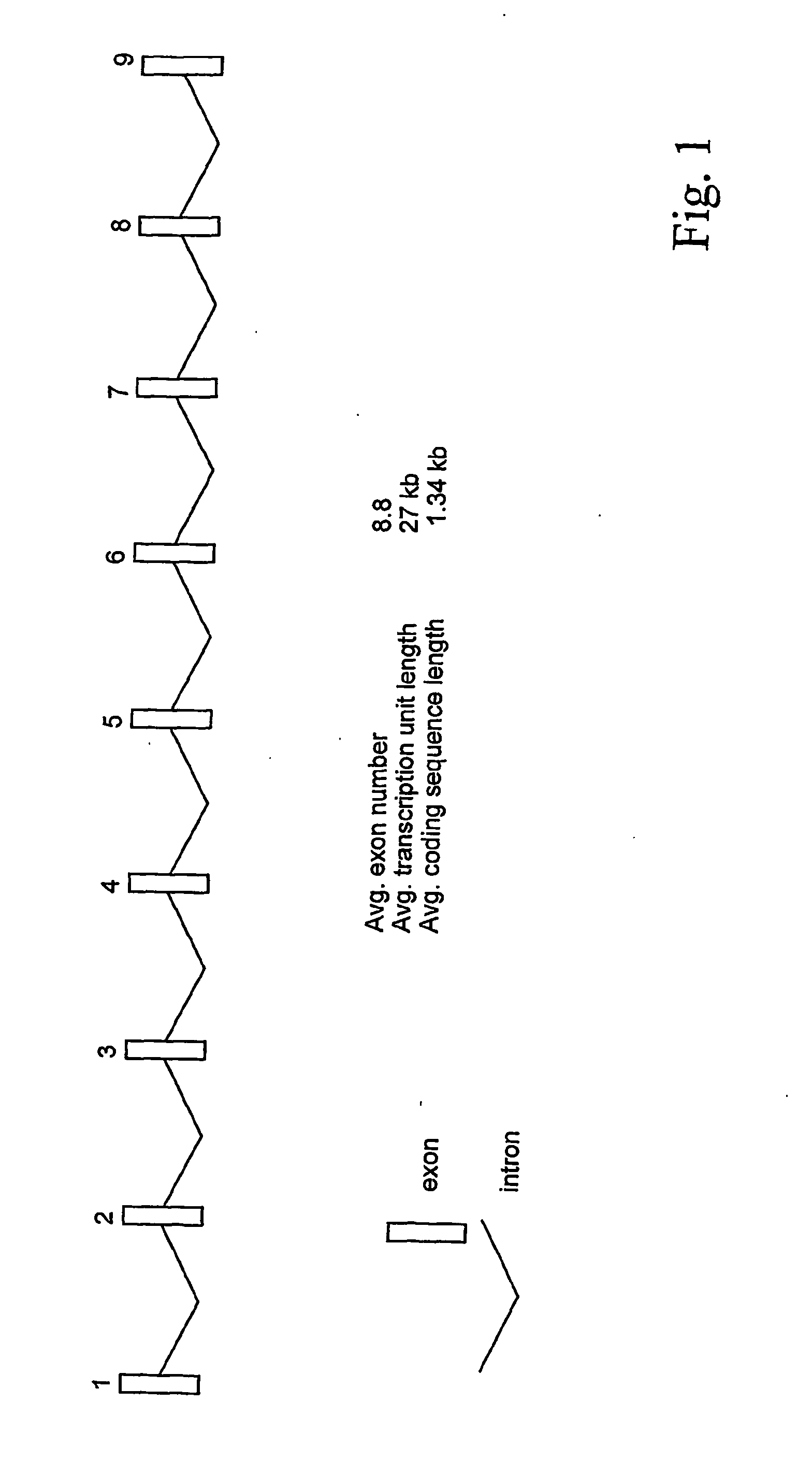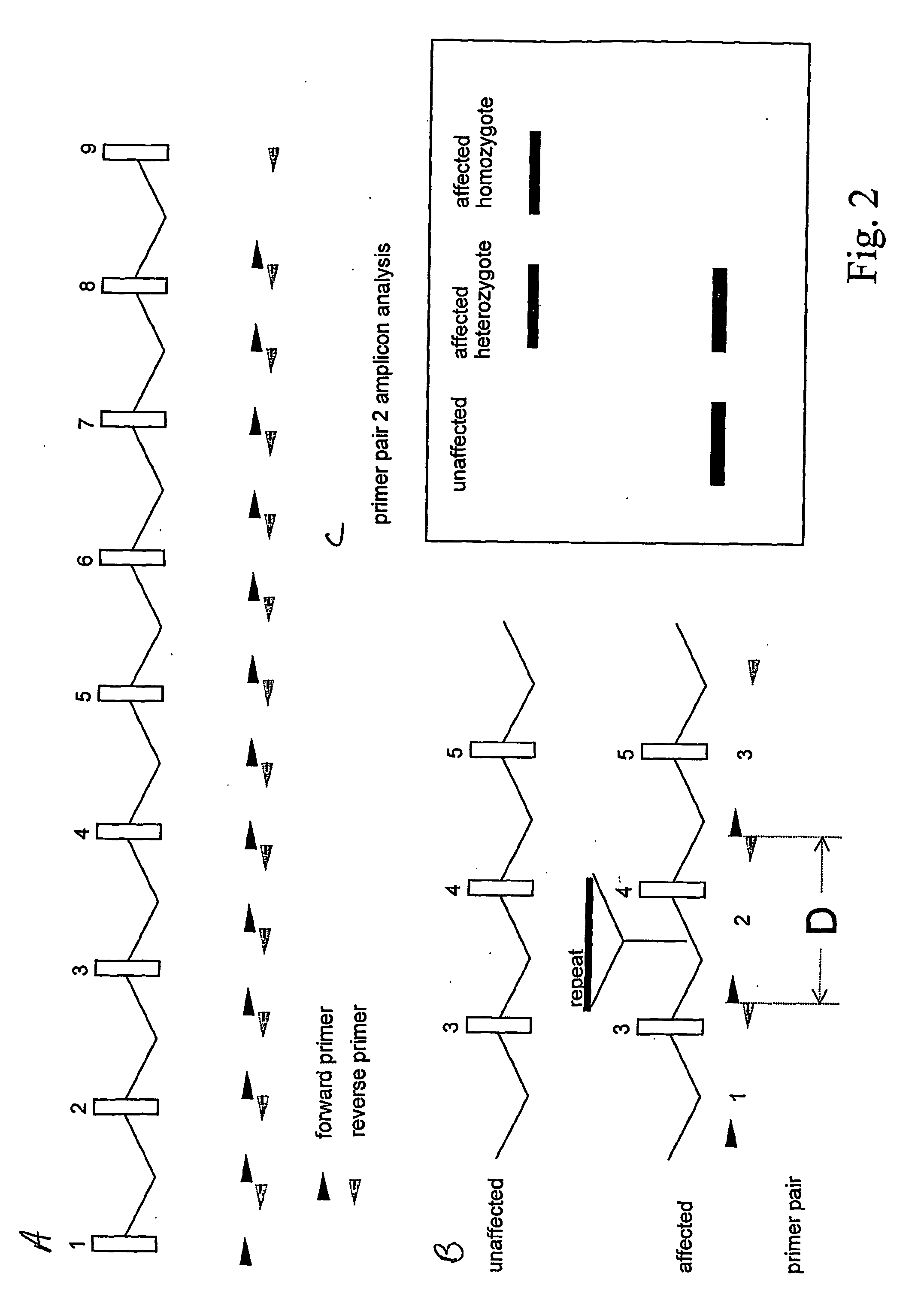Novel method for finding mutations caused by the insertion of repeated dnas
a repeat insertion and mutation technology, applied in biochemistry apparatus and processes, fermentation, organic chemistry, etc., can solve the problems of product amplitude less, profound ascertainment bias in genetic mutation analysis, and genetic disorders
- Summary
- Abstract
- Description
- Claims
- Application Information
AI Technical Summary
Benefits of technology
Problems solved by technology
Method used
Image
Examples
example 1
Search for Length Polymorphisms.
[0069] This method is outlined in FIG. 2. PCR (polymerase chain reaction) or related DNA amplification methods are employed to amplify insertion alleles up to 6 kb (the length of an L1 element) longer than the distance “D” between primer pairs (specifying the wild-type amplicon length). The primer pairs could be spaced every 1000 nucleotides (e.g.) throughout the transcription unit of interest and long PCR or related methods used to amplify the segments. The amplicons are electrophoretically separated to determine their size and the patterns are examined for the presence of bands larger than the predicted wild-type amplicon length. This method makes no assumption about the type of DNA inserted and thus it could detect new insertions from active transposon families as well as ancient insertions from transposon families that would be difficult to detect by other methods. If the insertion allele is heterozygous the intensity of the larger band will be ...
example 2
Search for Repeat-Specific Amplicons.
[0070] This method is outlined in FIG. 3. Individual primers located throughout a transcription unit will be used in combination with a variety of retrotransposon or other repeat-specific primers to amplify certain portions of genomes from affected and unaffected indicuduals. If the gene-specific primers are labeled (fluorescently or radioactively, e.g.) the amplicons could once again be visualized on gels and new bands present in affecteds versus unaffected controls could be sought. At least two primer pairs (corresponding to the two possible orientations of the repeat relative to the target) may be required for each type of retrotransposons family screened.
example 3
Human Repeat Array (HuRA) Detection Method.
[0071] This method is outlined in FIG. 4. This method begins with the steps outlined in Method 2—PCR (polymerase chain reaction) or related DNA amplification methods are employed in the first step.
[0072] Primer pairs amplify insertion alleles up to 6 kb longer than the distance between the primer pairs. The primer pairs may are spaced every 1000 nucleotides throughout the transcription unit of interest and long PCR or a related amplification technique could be used to amplify the segments.
[0073] The amplicons are analyzed with the Human Repeat Array (FIG. 5), ideally containing all known human repeat sequences, which can be found in the publicly available human genome sequence. For example, the modern human L1 sequence, L1Hs, represented by a consensus sequence of about 6000 nucleotides, could be split into overlapping or nonoverlapping oligonucleotides of length “o”. With the assumption that “o” is 60 nucleotides. Thus, the array compo...
PUM
| Property | Measurement | Unit |
|---|---|---|
| length | aaaaa | aaaaa |
| amplicon length | aaaaa | aaaaa |
| electrophoretic separation | aaaaa | aaaaa |
Abstract
Description
Claims
Application Information
 Login to View More
Login to View More - R&D
- Intellectual Property
- Life Sciences
- Materials
- Tech Scout
- Unparalleled Data Quality
- Higher Quality Content
- 60% Fewer Hallucinations
Browse by: Latest US Patents, China's latest patents, Technical Efficacy Thesaurus, Application Domain, Technology Topic, Popular Technical Reports.
© 2025 PatSnap. All rights reserved.Legal|Privacy policy|Modern Slavery Act Transparency Statement|Sitemap|About US| Contact US: help@patsnap.com



